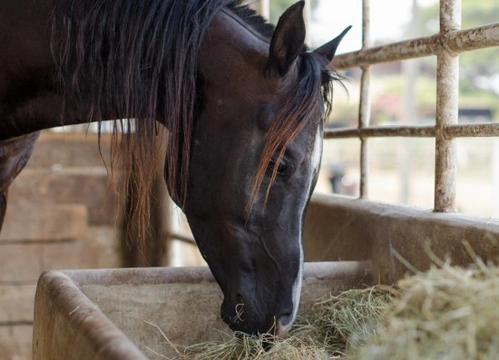
How to Feed a Post-Laminitic Horse
Feeding a post-laminitic horse or pony can be a real challenge but it can also be extremely rewarding to bring them back from this crippling disease and see them working again whether they are ridden for pleasure or competition. Sadly both horses and ponies can suffer from laminitis although many people believe it is just naughty, overweight ponies that are afflicted by the condition. There are several tell-tale signs that maybe a horse or pony has suffered from laminitis in the past with one being marked rings and ridges on their hooves but often it's hard to know whether they have had laminitis or not.
Some horses go lame on a regular basis and it can be hard to find the root cause of their condition. This can often prove to be really frustrating for both owners and vets. However, after in-depth examinations of a horse's hooves which includes MRIs, laminitis is found to be the cause which can come as quite a shock to many owners who don't quite understand how this happens. If the truth be known very often it is a mystery even to vets, blacksmiths and other equine specialists too.
Managing Your Horse's Diet is Crucial
For whatever reason laminitis rears its ugly head, the most important thing is to manage the condition in order to improve things and to make life a lot more comfortable for the horse. The first thing to understand is that many horses that develop laminitis often become much less tolerant to high levels of sugars and starch in their diets. The same can be said of non structural carbohydrates, otherwise known as NSCs.
Horses and ponies afflicted with laminitis, Equine Metabolic Syndrome, Cushings Disease, Polysaccharide Storage Myopathy and certain other conditions must be fed a diet that is strictly controlled and this has to be for the remainder of their lives with the end goal being to reduce the NSCs they ingest.
Alfalfa Hay
Although you may not think so, alfalfa hay is far lower in non-structural carbohydrates that grass cut hay is. Feeding a horse or pony who has suffered from laminitis alfalfa hay is important but you have to feed the right quantities to fit their size and body condition which is a crucial factor when working out how much alfalfa hay to feed on a daily basis.
No Going Out to Grass
Post-laminitic horses and ponies should not go out to grass because grass has high levels of sugar which you want to avoid at all costs in laminitic animals. However, if you feel your horse needs to stretch their legs, you can always put them out for half and hour or so making sure they are wearing a ""bucket/muzzle"" you are absolutely sure they can't get off!
Timothy Grass in Pellet Form
Timothy grass can be fed to a post-laminitic horse or pony in small amounts to offer a little of variety to their diets. Timothy grass is low in NSCs so it is safe to feed. However, quantities need to be carefully calculated according to weight and condition as well as the amount of exercise the horse or pony is given on a daily basis. If body condition is good and they are back in full work their energy intake has to match the energy that's spent on a daily basis.
The thing to remember is that one feed that may be suitable for post-laminitic horses or ponies with good body condition may not be suitable at all for those with a poor body condition and animals that have been diagnosed as suffering from Equine Metabolic syndrome.
Top Tips For Feeding Post-Laminitic Horses and Ponies
- It is important for dry matter intake to be 2.5% of bodyweight
- Hay needs to be soaked for at least 12 hours prior to feeding
- Vitamins, minerals and protein need to be well balanced & supplemented if need be
- You have to ensure the number of calories (MJ of digestible energy) eaten are less that those expended
- Grass provides the highest amount of calories so this has to be avoided
- If you put your horse or pony out to grass make sure they wear a bucket/muzzle they cannot get off. A horse moving around will use up a lot more calories than one that is standing in a stable
- Never try to starve your horse back to health – this could lead to a condition called hyperlipaemia – high blood fat. Your horse has to lose weight slowly and intelligently if being overweight is the root cause of their laminitis
- Weigh all food you give your horse so you know exactly how much they are being fed
- Do not rug up a laminitic or post-laminitic horse – a horse uses up around 80% of feed energy in order to stay warm
Conclusion
Monitoring and conscientiously weighing all the food you give your horse is crucial if they are post-laminitic. There is no ""quick fix"" for this horrible, complicated and crippling equine disease that can prove fatal. Taking care of a horse or pony that is recovering from laminitis is a long term commitment but one that is very rewarding especially when the horse or pony can be put into work again.
""



